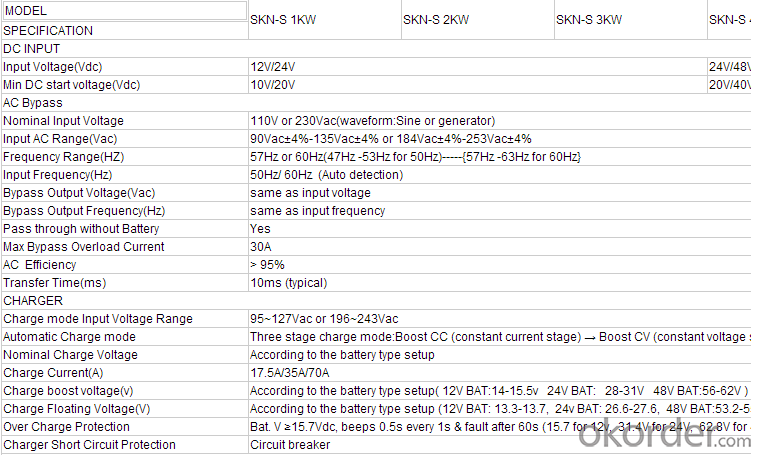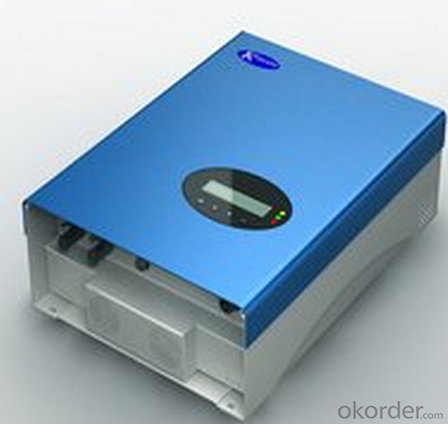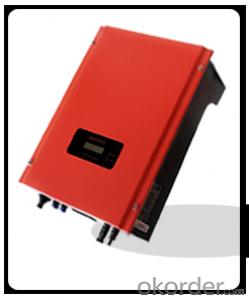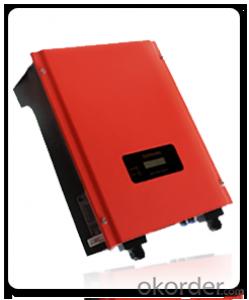Solar Inverters Sunteams 1500 to 3000 US ETL from China
- Loading Port:
- China main port
- Payment Terms:
- TT or LC
- Min Order Qty:
- 1 watt
- Supply Capability:
- 10000000 watt/month
OKorder Service Pledge
OKorder Financial Service
You Might Also Like
Description:
The Sunteams (US) 1500 ~5000 series isapplicable to various rooftops and small scale photovoltaic grid connected power plants. Their nominal output powers are 1.5 kW, 2 kW, 2.5 kW, 3 kW, 4 kW and 5kW respectively with Certificate ETL (220V/60HZ).
This series is transformerless and has a wide range of MPPT input voltage. Itsmaximum conversion efficiency and MPPT tracking accuracy reach 97.6 % and 99.5% respectively. The maximum DC voltage reaches 550 V. Its multilingualLCD display facilitates easy operation. It has waterproof direct plug-interminals. It has overvoltage, islanding, short-circuit, overloading andoverheating protection functions. Its IP65 protection degree will ensure itruns well in various tough environments.
These units are available with or without wirebox.


FAQ:Pls introduce more about CNBM?
CNBM is a China state owned company ,one of Global Fortune 500 .
- Q:What is the role of a solar inverter in a solar power system?
- The role of a solar inverter in a solar power system is to convert the direct current (DC) electricity generated by the solar panels into alternating current (AC) electricity that can be used to power appliances and devices in homes or businesses. It also regulates and optimizes the flow of electricity to ensure maximum efficiency and safety in the solar power system.
- Q:What are the common fault indications in a solar inverter?
- Some common fault indications in a solar inverter include error codes displayed on the inverter's screen, abnormal or fluctuating power output, frequent tripping or shutting down of the inverter, unusual noises or vibrations, and failure to connect or communicate with the monitoring system. These fault indications often suggest issues such as overheating, overvoltage, overcurrent, ground faults, or component failure within the inverter.
- Q:What is the maximum DC input current that a solar inverter can handle?
- The maximum DC input current that a solar inverter can handle depends on the specific model and its design specifications. It can range from a few amps to several hundred amps, depending on the power capacity and intended usage of the inverter. It is important to consult the manufacturer's specifications to determine the exact maximum DC input current for a specific solar inverter.
- Q:How does a solar inverter work?
- A solar inverter works by converting the direct current (DC) electricity generated by solar panels into alternating current (AC) electricity that can be used to power appliances and feed into the electrical grid. It does this by using electronic circuits to convert the DC electricity into a usable form that matches the voltage and frequency of the AC electricity. This conversion process involves several stages, including rectification, filtering, and inversion, which ultimately enables the solar energy to be utilized effectively.
- Q:How do you choose the right size solar inverter for your system?
- To choose the right size solar inverter for your system, you need to consider several factors. Firstly, determine the maximum power output (in watts) of your solar panels. This information can usually be found in the manufacturer's specifications. Next, calculate the total wattage of all your solar panels combined. Once you have this figure, select an inverter with a capacity slightly higher than your total wattage to allow for any future expansions or efficiency losses. Additionally, consider the type of inverter (string or micro) depending on your system layout and shading issues. Lastly, ensure that the inverter is compatible with your specific solar panel technology and has the necessary certifications and warranties for reliable performance.
- Q:What are the potential risks of overheating a solar inverter?
- The potential risks of overheating a solar inverter include reduced efficiency and decreased lifespan of the inverter, potential damage to internal components, increased risk of electrical fires, and potential disruptions to the solar power system's operation.
- Q:How does a solar inverter protect against power surges?
- A solar inverter protects against power surges by incorporating surge protection devices and circuitry within its design. These devices are designed to detect and divert excessive voltage levels caused by power surges, thereby preventing damage to the inverter and the connected solar panels.
- Q:What is the typical installation process for a solar inverter?
- The typical installation process for a solar inverter involves several steps. First, the inverter is mounted in a suitable location, usually close to the solar panels and near the electrical service panel. Then, the DC input wires from the solar panels are connected to the DC input terminals on the inverter. The AC output terminals of the inverter are then connected to the electrical service panel, allowing the generated electricity to be fed into the grid or used by the household. Finally, the inverter is connected to a monitoring system, which enables the user to track the performance and energy production of the solar system. It is important to note that the installation process may vary depending on the specific inverter model and the local electrical codes and regulations.
- Q:Can a solar inverter be used with batteries for energy storage?
- Yes, a solar inverter can be used with batteries for energy storage. The solar inverter converts the DC (direct current) electricity generated by the solar panels into AC (alternating current) electricity that can be used to power household appliances. When connected to batteries, the excess solar energy generated during the day can be stored in the batteries for later use, such as during nighttime or when the solar panels are not producing enough electricity. This allows for a more efficient and reliable use of solar energy.
- Q:What is the role of a solar inverter in voltage and frequency regulation during islanding conditions?
- The solar inverter plays a crucial role in maintaining voltage and frequency regulation during islanding conditions. Islanding conditions occur when a distributed generation system, like a solar PV system, continues to supply power to a local area even when the main electrical grid is disconnected. In grid-connected mode, the solar inverter synchronizes its output voltage and frequency with the utility grid. However, during islanding conditions, it must transition into a standalone mode and take responsibility for regulating voltage and frequency within the isolated microgrid. The primary function of the solar inverter in islanding conditions is to ensure that the voltage and frequency of the generated electricity remain within acceptable limits. To achieve this, it constantly monitors the electrical parameters and adjusts its own output accordingly. To regulate voltage, the solar inverter adjusts its output voltage based on demand and the available power from the solar panels. It maintains a steady voltage level within a specified range, typically around 230-240 volts for residential applications. Equally important is frequency regulation, which ensures that the electrical devices connected to the microgrid operate at their designed frequency, usually 50 or 60 Hz. The solar inverter continuously monitors the frequency and adjusts its output to match the required frequency, minimizing fluctuations and maintaining stability. Apart from voltage and frequency regulation, the solar inverter also performs other crucial functions during islanding conditions. These include power quality control, protection against overvoltage and overcurrent, and safe disconnection in emergencies or during grid restoration. Overall, the solar inverter's role in voltage and frequency regulation during islanding conditions is critical for maintaining a stable and reliable power supply within the isolated microgrid. It ensures that the electricity generated by the solar PV system remains within acceptable parameters, enabling connected electrical devices to operate efficiently and safely.
1. Manufacturer Overview |
|
|---|---|
| Location | |
| Year Established | |
| Annual Output Value | |
| Main Markets | |
| Company Certifications | |
2. Manufacturer Certificates |
|
|---|---|
| a) Certification Name | |
| Range | |
| Reference | |
| Validity Period | |
3. Manufacturer Capability |
|
|---|---|
| a)Trade Capacity | |
| Nearest Port | |
| Export Percentage | |
| No.of Employees in Trade Department | |
| Language Spoken: | |
| b)Factory Information | |
| Factory Size: | |
| No. of Production Lines | |
| Contract Manufacturing | |
| Product Price Range | |
Send your message to us
Solar Inverters Sunteams 1500 to 3000 US ETL from China
- Loading Port:
- China main port
- Payment Terms:
- TT or LC
- Min Order Qty:
- 1 watt
- Supply Capability:
- 10000000 watt/month
OKorder Service Pledge
OKorder Financial Service
Similar products
New products
Hot products
Hot Searches
Related keywords






























